St. Augustine to Beaufort, SC
Days 155 – 161 April 8-14
St. Augustine
I had prepared a real (as opposed to quick) dinner to serve Mark and Pauline. Plans on a sailboat are always subject to change. After docking at the St. Augustine City Marina, we ran into Donna and Jerry Luh, whom we had met at Vero Beach. Another small world experience -- they’re good friends with cruisers we had dinner with in Jacksonville, Tom and Joyce Russell. We invited Donna and Jerry back to our boat and found Mark and Pauline on board. After drinks and hors de’ oeuvres, the dinner menu changed to “reservations.” We went out to dinner at O.C. White’s, in the historic district, with Mark and Pauline.
One of the neat things about this trip has been, and continues to be, learning interesting facts about the places we travel though. This morning we took the Trolley Tour of St. Augustine with Mark and Pauline. St. Augustine is the oldest city in the United States. Ponce de Leon came to the area first with Columbus. On his second trip to the New World, he brought 76 ships with him… looking for Bimini. In 1513, he landed at what is now St. Augustine and claimed all of North America for Spain. Here he discovered what he thought to be “The Fountain of Youth.” Ponce de Leon was the tallest of the Spaniards on his ships, measuring all of 4’ 11”. Most of his crew were 4’ 5” to 4’ 8.” In 1695, the Spaniards built Castillo San Marcos Fort, constructed with over 500,000 coquina blocks. St. Augustine remained a walled city for 250 years. French, Spanish, Indians, and British fought over the area for several hundred years.
Florida became the 27th state in 1835. In 1885, the School for the Deaf and Blind was established in St. Augustine. It now serves over 800 students. One of its more famous students was Ray Charles, who spent eight years there during the 1950’s.
Henry Flagler made his mark on this city. A poor boy born in New York State, he left home at the age of 14 with $1.00 in his pocket. He became a multimillionaire, making most of his money as a partner with Rockefeller in Standard Oil. He was also a hotel and railroad magnate and contributed significantly to the development of Florida’s east coastal area. Flagler built the Florida East Coast Railway, extending it across the keys and making Key West accessible to tourists for the first time by land. From 1885 to 1887, he erected the Ponce de Leon Hotel, the flagship of his hotel system. It was the “Winter Newport” for millionaires. In 1890, the cost to stay for three months (no lesser period of time was allowed) was $250,000. The price, however, did include all the meals. At the entrance to the college is a fountain with 12 turtles on the outside circle and 4 frogs in the center. The turtles are a sundial, and the frogs mark the four seasons of the year. The hotel was the epitome of opulence. It is now Flagler College, and Florida residents attend free of charge. The college has the world’s largest collection of Tiffany glass windows and chandeliers.
St. Augustine to Shellbine Creek
Leaving St. Augustine Municipal Marina took some planning. The current and tides are notoriously strong here, requiring cruisers to leave at slack tide. The dock master warned, “If you wait an hour past slack tide, you may end up pinned broadsides against the pier behind you waiting for the next slack. Lots of boats do that.” We pulled away at 6:45AM, slack tide, without a problem.
We motorsailed 81 statute miles, a 10-hour day on the water, and anchored in Shellbine Creek at MM 697. The anchorage was nice, but the current was very strong and the bugs were horrific! When we arrived at Jekyll Island the next day, our hull was covered with black insects!
Jekyll Island
Jekyll Island is one of 13 barrier islands off the coast of Georgia. We stayed one night at the Jekyll Island Marina and spent the day riding bicycles around the island. We visited the historic district and enjoyed learning about the Jekyll Island Club, an area of history neither Bob nor I was familiar with.
Jekyll Island was purchased for $125,000 in 1886 by a group of 50 millionaire naturalists from the Union Club in New York City. The Jekyll Island Club was constructed over a period of several years and became their hunting and fishing retreat three months of the year. Like the Flagler Hotel, many of the patrons came from their Newport mansions to winter here. A few of the club members were the Pulitzer’s, Vanderbilt’s, Harvester’s, Goodyear’s, Rockefeller’s, Carnegie’s, Mellon’s, and J.P.Morgan.
The first condominium in the United States, Sans Souci, was built here near the clubhouse to give the five owners more privacy than the hotel provided. It was called the house of power due to its occupants: J.P. Morgan, James A. Scyrmsee, William Rockefeller, William Anderson, and Joseph Stickney.
As the resort developed, a number of “cottages” were built. Crane Cottage (owned by the Crane Plumbing magnate) was the most expensive of all; the workers were brought from Chicago to build it. None of the cottages at the Jekyll Island Club had kitchens. Everyone was expected to gather at the main hotel for their evening meal, which typically lasted three to four hours. Men wore tuxedos and the ladies were expected to appear in a different gown each evening. Consequently, many trunks of clothing arrived with each woman.
Theodore Vale, the President of AT&T, initiated the first transcontinental phone call from his home on Jekyll. The call was to have originated from New York City, but Mr. Vale was ill with a bout of gout and unable to travel. Lines were laid from NYC to Jekyll Island so he could participate in the four-hour call.
The Federal Reserve was started on Jekyll Island; participants for the meeting came in under the guise of a duck hunting trip.
The Jekyll Island Club prospered for over 40 years. Its demise began in the Great Depression. During World War II, owners defaulted on taxes and stopped maintaining the buildings. The State of Georgia condemned the property and took possession of it.
Killkenny Creek and Bull Creek Anchorages
We left Jekyll Island Marina later than planned due to a dense fog, but we still managed to cover 83 statute miles. We weren’t anchored in Kilkenny Creek more than a few minutes when an IP32 arrived. The name on the boat was “Curieuse.” It was the boat we looked at buying from our marina in Willsboro Bay on Lake Champlain. The folks who bought her had never sailed before taking a vacation in Florida and spending one day aboard a sailboat. They sold their house, left their jobs, and sailed “Curieuse” away. Sherry and Dan have been in the Abacos all winter and are returning to Connecticut for the summer. They spent the evening aboard DeLaMer, sharing their adventures with us.
Crossing the Savannah River, we left Georgia behind and entered South Carolina. We anchored in Bull Creek just as a front approached with 20-30 knot winds. Once again “Curieuse” pulled in behind us. We spent a quiet evening listening to the rain and winds.
Beaufort, SC
We will be here two days. Bob has some boat work to do and our friends, Bob and Lynn, whom we cruised the ICW south with last fall, are here. This morning Bob replaced the gas piston that holds the refrigerator lid up. It was under warranty and as usual, the Caliber folks were very responsive; they overnighted it to us at Jekyll Island. As I write the blog, Bob is changing the oil and fuel filters and the engine and transmission oil. We have a number of other boat maintenance chores planned for the rest of today and tomorrow before again heading north.
Monday, April 14, 2008
Subscribe to:
Post Comments (Atom)














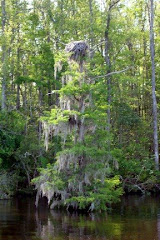









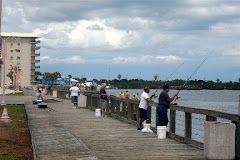









































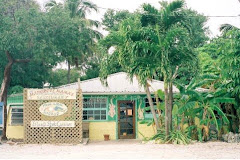









































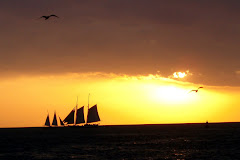




































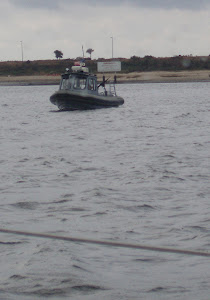
























































No comments:
Post a Comment